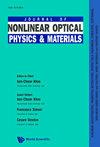Accelerated design of chalcogenide glasses through interpretable machine learning for composition–property relationships
IF 2.3
4区 物理与天体物理
Q2 OPTICS
引用次数: 1
Abstract
Chalcogenide glasses (ChGs) possess various outstanding properties enabling essential applications, such as optical discs, infrared cameras, and thermal imaging systems. Despite their ubiquitous usage, these materials’ composition–property relationships remain poorly understood, impeding the pace of their discovery. Here, we use a large experimental dataset comprising ∼24 000 glass compositions made of 51 distinct elements from the periodic table to develop machine learning (ML) models for predicting 12 properties, namely, annealing point, bulk modulus, density, Vickers hardness, Littleton point, Young’s modulus, shear modulus, softening point, thermal expansion coefficient, glass transition temperature, liquidus temperature, and refractive index. These models are the largest regarding the compositional space and the number of properties covered for ChGs. Further, we use Shapley additive explanations, a game theory-based algorithm, to explain the properties’ compositional control by quantifying each element’s role toward model predictions. This work provides a powerful tool for interpreting the model’s prediction and designing new ChG compositions with targeted properties. Finally, using the trained ML models, we develop several glass-selection charts that can potentially aid in the rational design of novel ChGs for various applications.通过可解释的机器学习来加速设计硫系玻璃的组成-性质关系
硫系玻璃(ChGs)具有多种优异的性能,可用于光盘、红外相机和热成像系统等重要应用。尽管这些材料被广泛使用,但人们对它们的组成-性质关系仍然知之甚少,这阻碍了它们的发现步伐。在这里,我们使用一个大型实验数据集,包括由元素周期表中的51种不同元素组成的约24000种玻璃成分,以开发机器学习(ML)模型来预测12种性质,即退火点、体积模量、密度、维氏硬度、利特尔顿点、杨氏模量、剪切模量、软化点、热膨胀系数、玻璃转变温度、液相温度和折射率。这些模型在组成空间和chg覆盖的属性数量方面是最大的。此外,我们使用Shapley加性解释,一种基于博弈论的算法,通过量化每个元素对模型预测的作用来解释属性的组成控制。这项工作为解释模型预测和设计具有目标性质的新ChG组合物提供了有力的工具。最后,使用训练好的ML模型,我们开发了几个玻璃选择图表,这些图表可能有助于为各种应用合理设计新型chg。
本文章由计算机程序翻译,如有差异,请以英文原文为准。
求助全文
约1分钟内获得全文
求助全文
来源期刊
CiteScore
3.00
自引率
48.10%
发文量
53
审稿时长
3 months
期刊介绍:
This journal is devoted to the rapidly advancing research and development in the field of nonlinear interactions of light with matter. Topics of interest include, but are not limited to, nonlinear optical materials, metamaterials and plasmonics, nano-photonic structures, stimulated scatterings, harmonic generations, wave mixing, real time holography, guided waves and solitons, bistabilities, instabilities and nonlinear dynamics, and their applications in laser and coherent lightwave amplification, guiding, switching, modulation, communication and information processing. Original papers, comprehensive reviews and rapid communications reporting original theories and observations are sought for in these and related areas. This journal will also publish proceedings of important international meetings and workshops. It is intended for graduate students, scientists and researchers in academic, industrial and government research institutions.

 求助内容:
求助内容: 应助结果提醒方式:
应助结果提醒方式:


